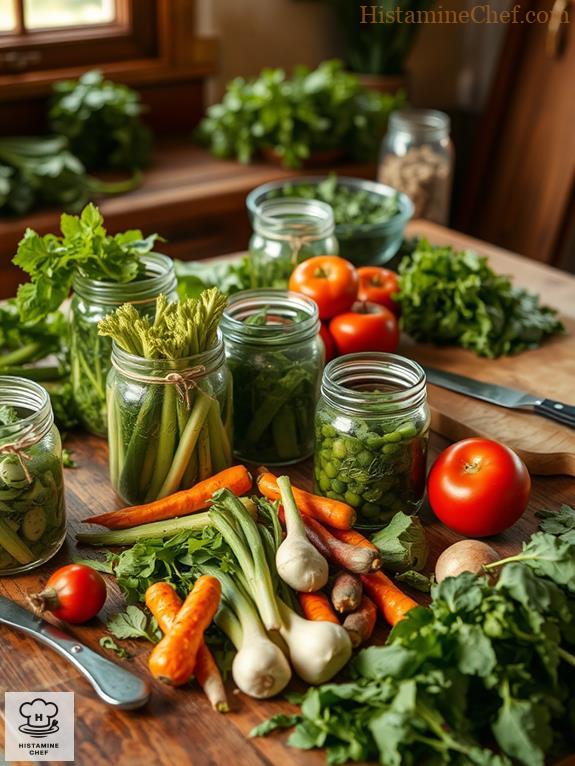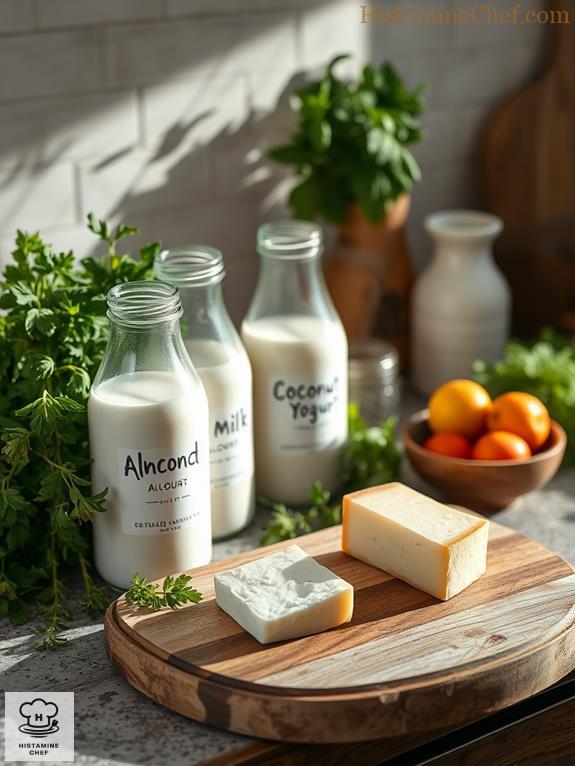Histamine nightmares keeping you up? I’ve got the scoop on low-histamine food storage!
I learned the hard way after a nasty reaction to leftover fish. Now, I’m a pro at keeping histamine levels in check.
Fridge those perishables ASAP! Two-hour rule is my lifesaver.
Airtight containers are your BFFs. No more soggy surprises!
Always consult the SIGHI list. Aged cheese? Not on my watch!
Wash, dry, separate. It’s my mantra for safe storage.
Frozen fruits? Total game-changer for flavor and nutrients.
Want more tips? Stick around, I’ve got plenty up my sleeve!
My Histamine Rollercoaster: From Hives to Histamine Chef
It all started with a wicked case of hives after a fancy restaurant meal. Talk about a wake-up call!
I dove headfirst into the world of histamine intolerance. Suddenly, I was juggling antihistamines, elimination diets, and food journals.
My kitchen became a lab, and I was the mad scientist. Through trial and error (and a few more hive outbreaks), I cracked the code on low-histamine cooking and storage.
Now, I’m sharing my hard-earned wisdom with fellow histamine warriors.
Understanding Histamine Levels

When it comes to managing low histamine levels, understanding the role of histamine in our food is vital. Histamine comes from various sources, and some foods can be sneaky histamine triggers. For instance, fermented foods like sauerkraut and yogurt can notably increase histamine levels in the body, making it important to be cautious with these items.
You see, histamine intolerance can lead to uncomfortable histamine reactions, like headaches or stomachaches—yikes!
To manage histamine levels effectively, we need to pay attention to histamine foods. Fresh veggies and certain fruits can be our best friends, while aged cheeses and processed meats are definitely not invited to the party!
I often refer to the SIGHI list to keep track of histamine levels in foods. By learning about histamine metabolism, we can better understand our histamine symptoms.
Best Storage Practices for Vegetables

Properly storing vegetables can make a significant difference in maintaining their freshness and low histamine levels.
I always wash my veggies before storage, making sure they’re dry. Moisture can lead to spoilage, which is a real bummer!
For leafy greens, I wrap them in a damp paper towel and place them in a breathable bag. It keeps them crisp and fresh, ideal for munching later!
And don’t forget about the fridge! Keeping veggies cool can extend their storage duration.
Now, if you’re wondering about high histamine offenders, stick to the SIGHI list! Avoid those restricted veggies like tomatoes and spinach.
Proper Fruit Preservation Techniques

When it comes to preserving fruits, I’ve found that keeping them at the right temperature is key to maintaining their freshness.
For instance, certain fruits thrive best in cool, dry places, while others may require refrigeration to prevent spoilage.
Using airtight containers can also work wonders—who wants their apples going soft and sad?
Additionally, freshness tips for low-histamine foods can provide further insights on how to properly handle and store your fruits.
And if you really want to stock up, freezing fresh options like berries is a game changer; just think of those vibrant pops of flavor in your smoothies!
Optimal Temperature Storage
Storing fruits at the right temperature is essential for maintaining their freshness and minimizing histamine buildup.
I’ve learned that temperature regulation is key! Most fruits like apples and pears do well in the fridge, while berries thrive in cooler spots.
Keeping them chilled not only extends their storage duration but also keeps histamine at bay.
Ever bitten into a warm, mushy peach? Not fun!
Remember, the fridge is your friend, but don’t crowd it—air circulation is important.
And don’t forget, some fruits, like bananas, prefer room temperature. Who knew fruit could be so picky?
Airtight Containers Usage
Airtight containers are my go-to for keeping fruits fresh and minimizing histamine buildup. When I store my favorite low-histamine fruits, like apples and blueberries, these containers really shine. The airtight benefits are undeniable! They keep moisture out and prevent unwanted odors from crashing the party.
Plus, I love using BPA-free plastic or glass container materials—safety first, right?
Have you ever opened a fridge to find your fruit looking sad and shriveled? It’s the worst! By using these containers, I can enjoy my fruits at their peak freshness. Just recall to rinse and dry them before storage.
Trust me; your taste buds will thank you. That’s why I write this blog, Histamine Chef—sharing tips to help you enjoy safe and delicious food!
Freezing Fresh Options
Freezing fresh fruits is a fantastic way to preserve their vibrant flavors and nutrients while keeping histamine levels low. I love the idea of stocking up on berries or peaches when they’re in season and freezing them for later.
When using freezing techniques, wash and dry your fruits thoroughly. Cut them into bite-sized pieces if needed, and lay them on a tray to freeze individually before transferring them to airtight bags. This prevents clumping—because who wants a frozen fruit block, right?
For thawing methods, try leaving them in the fridge overnight or using a microwave on low power. Enjoy the sweet taste of summer anytime! Trust me, your taste buds will thank you. Happy freezing!
Safe Storing of Starches

When it comes to ensuring the longevity and safety of starches, proper storage is key.
I’ve learned that different starch types, like quinoa or sweet potatoes, thrive in specific conditions. For instance, keep potatoes in a dark, cool place to prevent sprouting—no one wants a potato garden in their pantry!
You’ll also want to store grains in airtight containers. This keeps pests out and preserves their freshness.
The benefits of starches are fantastic; they provide energy and help keep you full.
But don’t forget to check the SIGHI list! Some starches, like buckwheat, can be tricky for those of us sensitive to histamines.
Handling Dairy and Alternatives

When it comes to handling dairy and alternatives, I’ve learned that proper storage can make all the difference!
I always check the SIGHI list to choose the safest options, like creamy ricotta or almond milk, while steering clear of those pesky high-histamine offenders.
For a delightful cheese alternative, consider using dairy-free cheese options that are low in histamine, such as cashew-based spreads or coconut yogurt.
Proper Storage Techniques
Maintaining the freshness of dairy products and alternatives is essential for anyone following a low histamine diet. I always make sure to check the food expiration dates before I buy them.
Proper ingredient sourcing is key; I stick to fresh, young cheeses and avoid fermented products like yogurt.
When meal prepping, I label leftovers with storage duration, so I recall when they need to be eaten or tossed. I practice food rotation, placing new items at the back of my pantry, ensuring older ones get used first.
Cleaning practices, like wiping down shelves, help keep things tidy, too!
Choosing Safe Alternatives
Finding safe alternatives to dairy can be a game-changer for those of us managing a low histamine diet.
I’ve discovered some fantastic safe substitutes that make my meals both delightful and compliant!
Almond milk, coconut milk, and oat milk are great choices, though be sure to check your tolerance.
Young cheeses like cream cheese and ricotta can also fit the bill!
But watch out for those restricted items—fermented dairy and aged cheeses can send your histamine levels soaring!
Let’s be honest; nobody wants to feel like a pinball machine after a meal!
So, when you’re steering through dairy alternatives, keep in mind to savor your options and keep things low histamine.
I write this blog to share my journey and help you find your culinary groove!
Meat and Fish Storage Guidelines

To guarantee the freshness and safety of meat and fish, it’s essential to follow proper storage guidelines.
I always make sure to buy fresh meat and fish types like chicken and salmon. Store them in the fridge, ideally at 32°F to 40°F, and use them within 1-2 days.
For frozen options, keep in mind to label them with storage durations—up to six months for meat!
When thawing, never let them sit out; use the fridge or cold water methods instead.
I also practice cross-contamination prevention by keeping raw and cooked items separate.
And don’t overlook portion sizes! This way, you’ll only cook what you need, keeping everything fresh.
Following these tips helps me stay safe and feel good, which is why I share on this blog!
FAQ
How Long Can I Store Low Histamine Foods Safely?
I’ve found that low histamine foods can last longer with proper refrigeration methods. Generally, most fresh items stay safe for about three to seven days, while frozen foods extend their shelf life considerably. Always check for freshness!
Are There Specific Containers for Low Histamine Food Storage?
When I store low histamine foods, I use glass containers with airtight lids and vacuum sealing. I prefer BPA-free options and stainless steel to keep food freshness high while ensuring safety and quality.
Can I Freeze Low Histamine Foods for Later Use?
Yes, I can freeze low histamine foods using proper freezing methods. When I’m ready to eat, I guarantee safe thawing by transferring them to the refrigerator overnight, keeping everything fresh and safe for consumption.
What Are Signs of Spoilage in Low Histamine Foods?
When I check for spoilage indicators in low histamine foods, I look for strange smells, unusual textures, or discoloration. These can increase histamine levels, making the food unsafe. Always trust your instincts for safety!
How Does Temperature Affect Histamine Levels in Stored Foods?
When it comes to ensuring food safety, I’ve found that temperature control greatly influences histamine production. Keeping foods at ideal temperatures prevents unwanted histamine buildup, making my meals not just safe but enjoyable too.
Summary
I’ve learned that proper food storage is crucial for managing my histamine intolerance. By following expert tips, I keep my kitchen safe and my meals fresh. Each mindful choice in storing food brings me closer to better health and enjoyable eating.
What’s your experience with food storage for low histamine diets? Share your tips and challenges in the comments below.
Help spread awareness about low histamine living by sharing this post on your social media. Your support helps Histamine Chef reach more people who could benefit from this information.


Leave a Reply